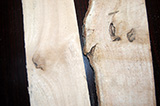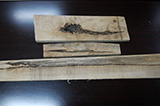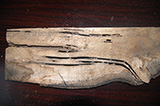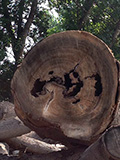Increased production of high-quality paulownia wood
In the whole growth process from planting to harvest cutting, the paulownia tree will be subjected to harms caused by nature and human activities, including: extreme temperatures, strong sunlight, drought, waterlogging, wind, insects, bacteria, viruses, damage by animal, injury by human and so on. Each harm caused by natural and human factors will leave scars in different sizes for the paulownia tree, which will be accurately recorded inside the tree body just like some “fossils”. And, those “fossiles” will impact quality of paulownia timber and timber utilization to some extent, thus decreasing quantity of high-quality timber produced by the entire paulownia commercial forest.
Some kinds of “fossils” commonly seen in the body of paulownia tree are as follows:















When sold to be processing factory after cutting down, paulownia timber will be categorized in accordance with differences on quality and utilization. Timber with high quality and high utilization will be ranked at the first grade, which will be preferred by the processing factory even though the price is at the top. Whereas, timber with poor quality and low utilization will be ranked at other grades at greatly lower prices compared with the first grade of paulownia timber.
Along with the diversification of market demand, paulownia tree from top to bottom has all become into useful material. As for paulownia commercial forest, larger quantity of high-quality paulownia timber means better economic benefits of the commercial forest and higher profits. On the contrary, economic benefits of the commercial forest will be poorer with lower profits if quantity of high-quality timber is small. According to our experience, it is hard for paulownia commercial forest to make a profit if quantity of high-quality timber is less than 40% of the total timber production. Therefore, to increase quantity of high-quality paulownia timber by reducing in-vivo “fossils” of the paulownia tree serves as a key factor for paulownia commercial forest to make a profit.
However, it is difficult to avoid impact and damage caused by environmental factors such as climate, soil, vegetation, worms, disease, insect, bird, animal, human and livestock in the whole process of paulownia’s growing.
For example, trunk surface of the paulownia tree will be burnt by long-time of sunlight shining in the hot summer. Without professional protection, burnt area on the trunk surface will get larger as time goes on.
Another example, various diseases will occur on the trunk due to frequent bacterial infection from the natural environment, which will result in extensive ulceration to the bark.
Again, trunk-boring insects in the nature will get into the trunk of paulownia tree and live there, leaving a variety of insect tunnels inside the trunk.
All these injuries will shape into scars in different figures and sizes after being treated. With continuous growth for many years, the tree will naturally wrap up those scars inside its body which will become into “fossils” of the paulownia tree that seriously impact quality and utilization of the paulownia timber.
Typically, the larger number and area of damages caused by various natural factors, the more and bigger will be for scars inside the tree body, where quality and utilization of the harvested timber will be poorer, of course, leading to lower economic values. In some cases, serious diseases can cause the whole tree even the entire plot of artificial forest becoming into waste material.
For instance, timber produced by paulownia tree infected by Waxuan disease will ringwise crack along the annual ring and become scrap when being sawed into boards. It is called as ring-shaped crack because the timber ringwise cracks along the annual ring. Waxuan disease can lead to large-scale infection of the whole plot of paulownia plantation. For slightly infected paulownia trees, ring-shaped cracks may occur at a certain or some sections of the trunk. For those seriously infected, no useful timber can’t be found on the trunk.
Hence, specialized cultivation techniques for paulownia shall be adopted according to afforestation purpose and actual situation of the planting site before building up paulownia commercial forests. Moreover, a forestation scheme shall be designed in scientific manners, under which natural factors not conducive to the growth can be evaded, thereby significantly reducing or completely avoiding many damages to the paulownia caused by natural environment.
For example, in order to mitigate the harm to paulownia commercial forest caused by low temperature and drought, paulownia species with cold-resistant and drought-tolerant features shall be selected for afforestation in cold areas under small amount of rainfall.
Another example, to avoid harm to the paulownia commercial forest caused by waterlogging, slope with a gradient less than 30° shall be selected for afforestation in the area with large amount of rainfall and high level of underground water.
Correct afforestation scheme and tending techniques which are professional and mature will minimize the shortcoming unavoidable in the afforestation scheme, which will greatly reduce the harm of natural environment to the paulownia, thus significantly and effectively increase the quantity of high-quality paulownia timber.
For example, although the afforestation scheme adopting the cold-resistant and drought-tolerant paulownia species has been selected for cold and less-rainfall areas, protection for freezing resistence and artificial watering shall be done in professional manners for saplings younger than two years to prevent harm caused by extreme low temperatures and extreme drought, where shortcoming of the afforestation scheme can be remedied.
Another example, a great deal of nutrients in the upper part of the slope will be washed away to the bottom by the rainfall, resulting in severe deficiency of nutrients. Thus, paulownia trees on the upper part will be in the unfavorable growing state with dramatically weak resistance, under which the tree will be susceptible to damage from disease and insects. Although having selected the afforestation scheme for the slop in areas with large rainfall and higher level of underground water, professional management on water and fertilizer must be conducted to promote resistance of paulownia trees growing in the upper part and mitigate damage from disease and insect, in a way to remedy shortcoming of the afforestation scheme.
Accordingly, to create paulownia commercial forests by adopting professional and mature techniques on paulownia afforestation will significantly reduce or completely avoid harms from natural environment to the paulownia. Besides, largest quantity of high-quality timber can be produced with a minimum investment within a short period, where we can obtain great economic benefits.
